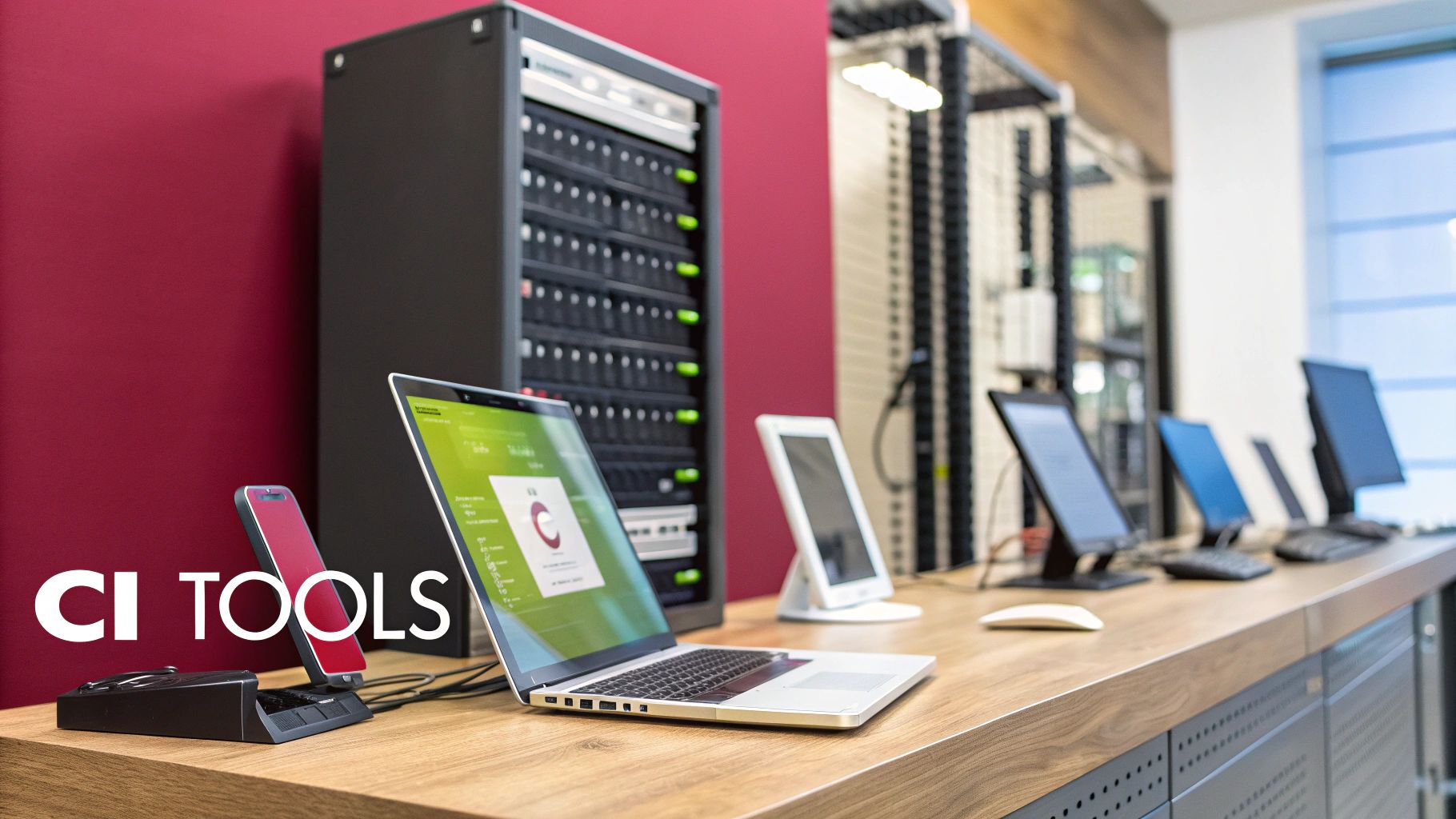The Evolution of Continuous Integration in iOS Development

In the fast-paced world of iOS development, releasing high-quality apps quickly and efficiently is paramount. This demand has made continuous integration (CI) a necessity. CI allows developers to integrate code changes frequently, automating the build, test, and deployment processes.
This automation reduces manual errors and speeds up the feedback loop, creating a smoother, more reliable development lifecycle.
Addressing the Challenges of the iOS Ecosystem
Continuous integration is especially important in iOS development because of the challenges presented by Apple’s ecosystem. The wide variety of iOS devices and operating system versions requires thorough testing to ensure compatibility.
Apple’s stringent app review process also demands high quality and stability, making rigorous testing essential. CI addresses these challenges by automating testing across different devices and OS versions, ensuring a consistent user experience.
This helps developers find and fix issues early in the development cycle, simplifying the app review process.
This move toward automation is reflected in market trends. The global continuous integration (CI) tools market was valued at approximately USD 542.7 million in 2024. It’s projected to grow to around USD 600.2 million by 2025, demonstrating the increasing adoption of CI worldwide.
This growth is driven by the need for faster software delivery and efficient testing, especially for iOS, where rapid iteration and high quality are key. For more statistics, see this report: Global Growth Insights CI Market Report
The Benefits of CI for iOS Development Teams
Adopting CI offers many advantages for iOS development. By automating time-consuming tasks, CI frees up developers to focus on building features and improving the user experience.
This results in faster release cycles, allowing teams to respond quickly to market demands and user feedback. CI also promotes better collaboration by providing a central platform for code integration and testing.
This improved collaboration leads to better code quality and lower development costs over time. Security in your CI/CD pipeline is also crucial, particularly when handling sensitive data. You can learn more here: Securing Your iOS CI/CD Pipeline.
Ultimately, continuous integration helps iOS development teams deliver high-quality apps more efficiently.
Building Your First iOS CI Pipeline That Actually Works
Building a robust continuous integration (CI) pipeline for iOS development presents unique challenges. Understanding these challenges and the tools available is key to creating a pipeline that streamlines your workflow and enhances your app’s quality.
Choosing the Right CI Platform
Selecting the right CI platform is the foundation of a successful iOS CI pipeline. Several popular platforms excel in supporting iOS builds, including Bitrise, CircleCI, and Xcode Cloud. Each platform offers different advantages and pricing models. Choosing one that aligns with your project’s needs and budget is essential.
For instance, Bitrise, with its free tier, might be a suitable starting point for smaller projects with limited resources. For larger teams and more complex projects, Xcode Cloud’s scalability and advanced features could be a better fit.
Managing Certificates and Provisioning Profiles
One of the most significant hurdles in iOS CI is managing code signing identities, certificates, and provisioning profiles. iOS requires these digital certificates to authorize app installations, unlike other mobile platforms.
This requires a secure and organized system for handling these assets within your CI environment. A common approach involves storing these files securely, possibly using a secrets management tool within your CI platform, and then injecting them into the build process at the appropriate stage.
Xcode Integration and Build Process
Integrating your Xcode project with the CI platform is the next crucial step. This usually involves defining a configuration file that specifies the build steps, dependencies, and testing procedures.
Within this configuration, you define the actions needed to build your app, like compiling the source code, running unit tests, and generating the final .ipa file. Automating these steps ensures consistency and repeatability across every build.

The infographic above illustrates a simplified iOS CI pipeline workflow. It highlights the core stages: Code Commit, Automated Build & Test, and Deploy to Test Environment. This visualization shows the linear progression of your code through the pipeline. Each code change triggers an automated build, followed by testing and deployment to a test environment.
Dependency Management and Version Control
Managing dependencies effectively is another critical aspect of a successful iOS CI pipeline. Tools like CocoaPods and Swift Package Manager simplify dependency resolution. They ensure that the correct versions of external libraries are included in your builds.
This reduces the risk of conflicts and ensures build consistency across different environments. A dependency manager can automatically update libraries, patch vulnerabilities, and streamline the integration process.
Automating Testing and Deployment
Automated testing is where CI’s true power becomes evident. Integrating automated unit and UI tests allows you to catch bugs early. This ensures your app functions correctly across various iOS versions and devices. Automation provides faster feedback loops and minimizes the risk of regressions in production.
After successful tests, the pipeline can automatically deploy your build to a test environment such as TestFlight, simplifying distribution and allowing testers easy access to the latest version. This drastically speeds up the testing and release cycle.
To help you choose the best CI solution for your iOS development, consider the following comparison table:
To help you choose the right platform for your needs, here’s a comparison of popular CI tools.
Top Continuous Integration Tools for iOS Development
| CI Tool | iOS-Specific Features | Pricing Model | Learning Curve | Integration Capabilities |
|---|---|---|---|---|
| Bitrise | Excellent Xcode support, device testing integrations | Free tier available, paid plans for more concurrent builds and build minutes | Relatively easy to learn, good documentation | Integrates with popular code repositories and communication tools |
| CircleCI | Robust iOS build infrastructure, support for fastlane | Free tier available, paid plans for more concurrency and resources | Moderate learning curve | Wide range of integrations with other development tools |
| Xcode Cloud | Seamless integration with Xcode, built-in testing and distribution | Part of Apple Developer Program membership | Easy to learn for Apple developers | Tightly integrated with Apple’s ecosystem |
This table summarizes key features of these CI platforms, enabling a quicker comparison based on your project requirements. Each tool offers a unique blend of features and pricing, so choosing the best one depends on your specific needs.
Mastering Automated Testing for iOS CI Pipelines

Automated testing forms the foundation of any successful iOS Continuous Integration (CI) pipeline. It’s the stage where your app’s quality and reliability undergo rigorous evaluation. Creating a comprehensive suite of tests ensures your app performs seamlessly across a range of iOS devices and operating systems. This ultimately leads to quicker release cycles and a more refined user experience.
Building a Comprehensive iOS Testing Strategy
Effective testing necessitates a multifaceted strategy. This typically involves a combination of unit tests, UI tests, and integration tests. Unit tests examine individual code components, while UI tests ensure the user interface operates correctly. Integration tests, conversely, verify the interplay between different application components.
For instance, a unit test might confirm a specific function calculates a value correctly. A UI test might verify that tapping a button triggers the expected action within the app. A balanced strategy incorporating all three test types is vital for upholding overall app quality and stability.
Testing Across Multiple Devices and iOS Versions
iOS devices come in a wide variety of models and screen sizes, each potentially running a different version of iOS. Testing your app across these variations is crucial to ensure a consistent user experience. Services like BrowserStack and Sauce Labs offer virtual device testing, enabling you to test on numerous devices without needing to physically own them.
This approach allows for comprehensive test coverage without the logistical and financial overhead of maintaining a large physical device lab. This ensures your app performs as expected, regardless of the device or iOS version your users have.
Additionally, the growing use of automated UI testing frameworks and Behavior-Driven Development (BDD) has markedly improved the quality of iOS apps. Automated UI testing tool adoption increased by 30% among iOS development teams last year. BDD implementation has resulted in a 35% decrease in bugs discovered during development. For more detailed statistics, see The Future of UI Testing.
Optimizing Test Performance and Reliability
Lengthy test execution times can bog down your CI pipeline. Techniques like test parallelization can significantly expedite this process. By running multiple tests concurrently, you can drastically reduce the total testing time.
For example, if you have 100 tests that typically take an hour to run, parallelization might shorten that to just a few minutes. A good CI/CD pipeline tutorial can help you get started with these optimization techniques. This faster feedback loop on code changes accelerates the entire development lifecycle.
Handling Flaky UI Tests
UI tests can sometimes be flaky, meaning they may pass or fail intermittently without any code changes. This inconsistency can undermine confidence in your test suite and disrupt your CI process. Techniques such as retry mechanisms and improved test isolation can minimize these problems.
Automatically rerunning failed tests helps identify genuinely problematic tests and filter out occasional glitches. Isolating tests – minimizing dependencies between them – reduces the chance of one test influencing the outcome of another. This helps pinpoint issues accurately and improves result reliability. A robust and reliable automated testing strategy is essential for maximizing the effectiveness of your iOS CI pipeline. A well-structured testing approach delivers higher quality apps, speeds up release cycles, and increases developer productivity.
From Integration to Deployment: Automating iOS Releases

Continuous integration (CI) is more than just merging code. It’s the foundation of a streamlined release process. This automation extends to deployment, enabling faster delivery of your iOS app to users. This section explores how leading development teams use CI to automate the process from code commit to app download.
Navigating Apple’s App Distribution Landscape
Deploying an iOS app involves navigating Apple’s specific requirements and platforms. This includes using TestFlight for beta testing and App Store Connect for release management. Automating these steps within your continuous integration iOS pipeline can significantly reduce manual work and potential errors.
This automation can include uploading builds to TestFlight, managing tester groups, and submitting your app for App Store review. Automated workflows ensure a consistent and repeatable deployment process.
Automating Version Management and Release Notes
Managing version numbers and generating release notes are essential parts of the release process. These tasks can be time-consuming, but fortunately, they can be automated within your CI pipeline. Tools like fastlane can automate incrementing version numbers based on your branching strategy and generate release notes from commit messages.
You can configure your pipeline to automatically increase the build number for every commit and generate release notes summarizing the changes included in each release. This eliminates manual updates and ensures consistency. This also saves developers time and reduces the risk of human error.
Feature Flags and Staged Rollouts
Modern iOS development increasingly uses techniques like feature flags and staged rollouts. Feature flags allow you to remotely enable or disable features, even after deployment. This is useful for A/B testing and targeted feature releases. Staged rollouts let you gradually release new versions to a subset of users, minimizing the impact of potential bugs.
These techniques offer a safety net, letting you disable problematic features or roll back releases without a full App Store update. This flexibility is essential for minimizing risk in continuous deployment and contributes to a more reliable release strategy. The evolution of iOS app development emphasizes these automated deployment practices. Learn more about these trends: iOS App Development Trends.
Streamlining App Signing and Compliance Checks
Code signing and compliance checks are critical for iOS app distribution. Integrating these steps into your CI pipeline ensures every build is correctly signed and meets Apple’s requirements. Automated signing removes manual work and reduces the risk of errors that can delay releases.
Automated compliance checks within the CI pipeline further streamline the process. These checks might include verifying app size, resource usage, and adherence to App Store guidelines. By catching potential issues early, you can prevent last-minute surprises during App Store submission. This accelerates the entire release cycle, ensuring a smooth path from development to deployment.
Optimizing Your iOS CI Pipeline for Maximum Performance
As your iOS project grows, even a well-designed continuous integration (CI) pipeline can become a bottleneck. This section explores practical strategies for optimizing your iOS CI pipeline, reducing build times, and improving reliability. These improvements will help your team develop faster and deliver better apps.
Identifying Performance Bottlenecks
Before making any changes, it’s essential to pinpoint the specific areas causing slowdowns. Data analysis is critical for this. Your CI platform, such as Fastlane, likely provides metrics on build times for each stage of your pipeline.
You might find that test execution takes too long, or dependency resolution slows down the build process. Identifying these bottlenecks focuses your optimization efforts where they’ll have the most impact. This targeted approach maximizes efficiency and delivers the best results.
Implementing Intelligent Caching Strategies
Caching is a powerful method for accelerating builds. By caching dependencies, build artifacts, and derived data, you avoid redundant work. This can drastically reduce build times, especially for large projects.
Consider caching dependencies managed by CocoaPods or Swift Package Manager. Caching intermediate build products also significantly cuts down on the time needed for subsequent builds. Smart caching strategies drastically improve your pipeline’s speed. This translates to faster feedback and quicker development cycles.
Parallelizing Build and Test Processes
Parallel execution is another valuable optimization. Running tests or build steps concurrently can significantly reduce the total time. This involves setting up your CI platform to use multiple build agents or machines.
For example, running UI tests across different simulators at the same time can dramatically shorten testing time. Similarly, parallelizing build processes, such as compiling various parts of your codebase concurrently, can speed up the entire build phase. This gets you faster feedback and enables more frequent releases.
Selective Testing Approaches
Running all tests for every code change can be excessive, particularly in larger projects. Selective testing involves running only the tests relevant to the changes made. This saves significant time and resources.
This is achieved by analyzing code changes and identifying the affected modules or components. Only the tests related to those areas are then executed. If a change is confined to the networking layer, for example, only the networking-related tests need to be run. This focused approach optimizes test execution time without compromising quality.
Monitoring and Continuous Improvement
Setting up dashboards and alerts to monitor key metrics like build times, test pass rates, and build failure rates is vital. This visibility helps you identify emerging problems and track the effectiveness of your optimizations.
Regularly review your pipeline’s performance and look for further improvements. This ongoing process ensures your CI pipeline stays efficient and continues to deliver value as your project evolves. Refer to the table below for industry benchmarks and optimization tips.
To help you assess your current CI pipeline performance, we’ve compiled a table of key metrics and industry standards. This table offers guidance and optimization strategies for achieving optimal efficiency.
iOS CI Pipeline Performance Benchmarks
| Metric | Poor Performance | Average Performance | Excellent Performance | Optimization Tips |
|---|---|---|---|---|
| Build Time | > 30 minutes | 15-30 minutes | < 15 minutes | Caching, parallelization |
| Test Execution Time | > 15 minutes | 5-15 minutes | < 5 minutes | Parallelization, selective testing |
| Build Failure Rate | > 10% | 5-10% | < 5% | Robust testing, error monitoring |
By tracking these metrics and implementing these optimizations, you can ensure your iOS CI pipeline remains fast, reliable, and contributes to the overall success of your app. Remember to continually adapt your strategy as your project grows and changes.
Securing Your iOS CI/CD Pipeline Against Modern Threats
A secure Continuous Integration/Continuous Delivery (CI/CD) pipeline is essential for protecting your iOS app, user data, and company reputation. While CI/CD offers significant advantages for iOS development, it also presents potential security vulnerabilities. This section explores key security practices to help you build a robust and secure iOS CI/CD pipeline.
Securely Managing Sensitive Credentials
Protecting sensitive credentials, such as API keys, code signing certificates, and provisioning profiles, is paramount. Hardcoding these credentials or exposing them in build logs is a serious security risk. Never embed secrets directly in your codebase.
Instead, use secrets management tools. Many CI platforms provide built-in solutions, or you can integrate with third-party services like HashiCorp Vault. These tools encrypt and securely store your sensitive data, injecting them into the build environment only when necessary. This minimizes the risk of exposure.
Implementing Secure Code Signing Practices
Code signing is a fundamental security measure for iOS, verifying the authenticity and integrity of your app. Managing code signing identities and certificates within an automated CI/CD environment, however, can be challenging.
Utilize dedicated code signing tools and adhere to best practices to prevent security breaches. Securely store your signing certificates, consider using hardware security modules (HSMs), and tightly control access, limiting which users and systems can access your signing keys.
Integrating Automated Vulnerability Scanning
Regularly scanning your codebase for vulnerabilities is essential. Integrating automated vulnerability scanning tools into your CI/CD pipeline is crucial. These tools analyze your code for common security flaws such as injection attacks, cross-site scripting (XSS), and insecure dependencies.
Automate these scans to run after each build or on a defined schedule to ensure continuous security assessment. Identifying vulnerabilities early in the development lifecycle significantly reduces the risk of security breaches.
Dependency Analysis and Compliance Verification
Third-party libraries are vital for iOS development but can introduce security risks. Use tools to perform automated dependency analysis. These tools scan your dependencies for known vulnerabilities, helping you use secure and up-to-date libraries.
Automated compliance verification further strengthens CI/CD security. This can involve checking for adherence to coding standards, license compliance, and company-specific security policies. Automating this process minimizes the risk of introducing non-compliant code and simplifies meeting security requirements.
Balancing Security and Development Velocity
Balancing security with the speed and agility of CI/CD can be difficult. Strive for a security-first approach without hindering development velocity. Prioritize the most critical security measures and automate as much as possible.
Establish clear security guidelines and integrate best practices into every stage of your CI/CD pipeline. By making security an integral part of your development process, you can create a robust and secure pipeline without sacrificing speed or efficiency.
Strong security practices are essential for any iOS CI/CD pipeline. By implementing these measures, you protect your app, your users, and your organization. Secure your CI/CD processes to ensure the long-term success of your iOS app.
Streamline your React Native app updates with CodePushGo, a platform that allows instant, secure over-the-air (OTA) updates. Bypass app store delays and deliver bug fixes, features, and patches quickly. Learn more about CodePushGo.




